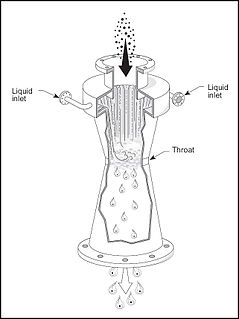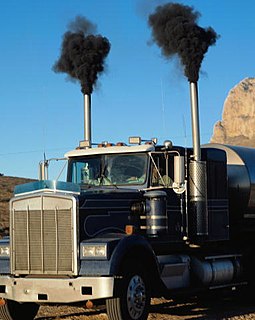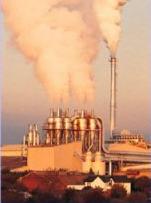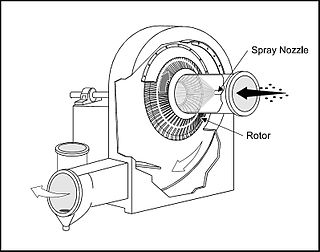An important parameter in wet scrubbing systems is the rate of liquid flow. It is common in wet scrubber terminology to express the liquid flow as a function of the gas flow rate that is being treated. This is commonly called the liquid-to-gas ratio (L/G ratio) and uses the units of gallons per 1,000 actual cubic feet or litres per cubic metre (L/m3).
Scrubber systems are a diverse group of air pollution control devices that can be used to remove some particulates and/or gases from industrial exhaust streams. The first air scrubber was designed to remove carbon dioxide from the air of an early submarine, the Ictineo I, a role for which they continue to be used today. Traditionally, the term "scrubber" has referred to pollution control devices that use liquid to wash unwanted pollutants from a gas stream. Recently, the term has also been used to describe systems that inject a dry reagent or slurry into a dirty exhaust stream to "wash out" acid gases. Scrubbers are one of the primary devices that control gaseous emissions, especially acid gases. Scrubbers can also be used for heat recovery from hot gases by flue-gas condensation. They are also used for the high flows in solar, PV, or LED processes.
Contents
Expressing the amount of liquid used as a ratio enables systems of different sizes to be readily compared. For particulate removal, the liquid-to-gas ratio is a function of the mechanical design of the system; while for gas absorption this ratio gives an indication of the difficulty of removing a pollutant. Most wet scrubbers used for particulate control operate with liquid-to-gas ratios in the range of 4 to 20 gallons per 1,000 actual cubic foot (0.5 to 3 litres per actual cubic metre).

A pollutant is a substance or energy introduced into the environment that has undesired effects, or adversely affects the usefulness of a resource. A pollutant may cause long- or short-term damage by changing the growth rate of plant or animal species, or by interfering with human amenities, comfort, health, or property values. Some pollutants are biodegradable and therefore will not persist in the environment in the long term. However, the degradation products of some pollutants are themselves polluting such as the products DDE and DDD produced from degradation of DDT.
Depending on scrubber design, a minimum volume of liquid is required to "wet" the scrubber internals and create sufficient collection targets. After a certain optimum point, adding excess liquid to a particulate wet scrubber does not increase efficiency and in fact, could be counter-productive by causing excessive pressure loss. Liquid-to-gas ratios for gas absorption are often higher, in the range of 20 to 40 gallons per 1,000 actual cubic foot (3 to 6 litres per actual cubic metre).
Pressure drop is defined as the difference in total pressure between two points of a fluid carrying network. A pressure drop occurs when frictional forces, caused by the resistance to flow, act on a fluid as it flows through the tube. The main determinants of resistance to fluid flow are fluid velocity through the pipe and fluid viscosity. Pressure drop increases proportionally to the frictional shear forces within the piping network. A piping network containing a high relative roughness rating as well as many pipe fittings and joints, tube convergence, divergence, turns, surface roughness, and other physical properties will affect the pressure drop. High flow velocities and/or high fluid viscosities result in a larger pressure drop across a section of pipe or a valve or elbow. Low velocity will result in lower or no pressure drop. The fluid may also be biphasic as in pneumatic conveying with a gas and a solid, in this case, the friction of the solid must also be taken into consideration for calculating the pressure drop
L/G ratio illustrates a number of points about the choice of wet scrubbers used for gas absorption. For example, because flue-gas desulfurization systems must deal with heavy particulate loadings, open, simple designs (such as venturi, spray chamber and moving bed) are used. Also, the liquid-to-gas ratio for the absorption process is higher than for particle removal and gas velocities are kept low to enhance the absorption process.

Flue-gas desulfurization (FGD) is a set of technologies used to remove sulfur dioxide from exhaust flue gases of fossil-fuel power plants, and from the emissions of other sulfur oxide emitting processes

A venturi scrubber is designed to effectively use the energy from the inlet gas stream to atomize the liquid being used to scrub the gas stream. This type of technology is a part of the group of air pollution controls collectively referred to as wet scrubbers.

A spray tower is gas-liquid contactor used to achieve mass and heat transfer between a continuous gas phase and a dispersed liquid phase. It consists of an empty cylindrical vessel made of steel or plastic, and nozzles that spray liquid into the vessel. The inlet gas stream usually enters at the bottom of the tower and moves upward, while the liquid is sprayed downward from one or more levels. This flow of inlet gas and liquid in opposite directions is called countercurrent flow.
Solubility is a very important factor affecting the amount of a pollutant that can be absorbed. Solubility governs the amount of liquid required (liquid-to-gas ratio) and the necessary contact time. More soluble gases require less liquid. Also, more soluble gases will be absorbed faster. [1]

Solubility is the property of a solid, liquid or gaseous chemical substance called solute to dissolve in a solid, liquid or gaseous solvent. The solubility of a substance fundamentally depends on the physical and chemical properties of the solute and solvent as well as on temperature, pressure and presence of other chemicals of the solution. The extent of the solubility of a substance in a specific solvent is measured as the saturation concentration, where adding more solute does not increase the concentration of the solution and begins to precipitate the excess amount of solute.










